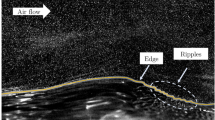Summary
A three-dimensional, time dependent hydrodynamic primitive equation model was used to simulate the distribution of nocturnal drainage winds, temperature, and turbulence in the California Geysers area. The case studied here (night 2) was under the condition that the ambient airflow was easterly and the direction of main drainage flow was westerly, The computed depth of drainage flow was less than 50 m at the ridge, and increased to 200 m at the valley, which agreed well with the observation. The computed wind speed at the ridge was smaller than the observation, but it agreed well at the valley site, Vertical wind variances measured by a doppler sodar indicated relatively large turbulence despite the fact that stable density stratification dominated throughout the night. The computed vertical wind variances were also larger than those observed over flat terrain, but smaller than the values recorded by the doppler sodar.
The computed wind vectors and turbulence were used to simulate the surface concentration of perflourocarbon trace gas. The model used is based on a random-particle statistical method. One particle per second was released for one hour at the source site, and the locations of particles were computed at every 10 sec. An imaginary box of 10x10x4 m (vertical) was considered at each of 39 surface sampling stations, and the number of particles collected for two hours was counted, from which concentration was determined. A cross-correlation coefficient of 0.82 was obtained between the computed and observed concentrations at the 39 sampling stations. Other statistics indicate that twenty percent of the computed concentrations were within a factor of two of the observations, 50% within a factor of 5 and 62% within a factor of 10.
Zusammenfassung
Zur Simulation des nächtlichen Abflusses, der Temperatur und der Turbulenz im kalifornischen Geysirgebiet wurde ein dreidimensionales, zeitabhängiges, hydrodynamisches Modell verwendet, das auf den Grundgleichungen beruht. Im hier untersuchten Fall war der vorherrschende Wind östlich, während der Abfluß aus westlicher Richtung erfolgte. Die Mächtigkeit des Abflusses wurde mit weniger als 50 m beim Kamm und etwa 200 m im Tal berechnet, was gut mit den Beobachtungen übereinstimmt. Die berechnete Windgeschwindigkeit war beim Kamm zu gering, entsprach aber im Tal den Beobachtungen. Mit Hilfe der berechneten Windvektoren und Turbulenzen war die Oberflächenkonzentration des ausgebrachten Perfluorkarbongases zu simulieren. Das verwendete Modell basiert auf einer “random walk”-Methode. Es wurde für die 39 Meßstellen ein Kreuzkorrelationskoeffizient von 0.82 zwischen beobachteten und berechneten Konzentrationen erreicht.
Similar content being viewed by others
References
Dickerson, M. H.: An Overview, Current Status, and Future Plans for the DOE Atmospheric Studies in Complex Terrain (ASCOT) Program. Second Conference on Mountain Meteorology, November 9–12, 1981, Steamboat Springs, Colorado, American Meteorological Society, pp. 10–13 (1981).
Gudiksen, P. H.: ASCOT Data From the 1980 Field Experiment Program in the Anderson Creek Valley, California. USID-88874-80, ASCOT-83-1, Lawrence Livermore National Laboratory, Vol. 1, 2, and 3, pp. 1589 (1983).
Yamada, T.: A Numerical Simulation of Nocturnal Drainage Flow. J. Met. Soc.59, 108–122 (1981).
Yamada, T.: A Numerical Model Study of Turbulent Airflow In and Above a Forest Canopy. J. Met. Soc.60, 439–454 (1982).
Yamada, T.: Simulations of Nocturnal Drainage Flows by aq 2 l Turbulence Closure Model. J. Atmos. Sci.40, 91–106 (1983).
Mellor, G. L., Yamada, T.: Development of a Turbulence Closure Model for Geophysical Fluid Problems. Rev. of Geophys. and Space Phys.20, 851–875 (1982).
Sasamori, T.: The Radiative Cooling Calculation for Application to General Circulation Experiments. J. Appl. Met.7, 721–729 (1968).
Mellor, G. L., Yamada, T.: A Hierarchy of Turbulence Closure Models for Planetary Boundary-Layers. J. Atmos. Sci.31, 1791–1806 (1974).
Yamada, T.: The Critical Richardson Number and the Ratio of the Eddy Transport Coefficients Obtained From a Turbulence Closure Model. J. Atmos. Sci.32, 926–933 (1975).
Dyer, A. J., Hicks, B. B.: Flux-Gradient Relationships in the Constant Flux Layer. Quart. J. R. Met. Soc.96, 715–721 (1970).
Yamada, T.: A Three-Dimensional, Second-Order Closure Numerical Model of Mesoscale Circulations in the Lower Atmosphere: Description of the Basic Model and an Application to the Simulation of the Environmental Effects of a Large Cooling Pond. ANL/RER-78-1, Argonne National Laboratory, Argonne, Illinois, pp. 67 (1978).
Coulter, R. L., Martin, T. J.: Remote Sensing of Winds and Turbulence Above Complex Terrain During ASCOT-1980. ANL/ER-83-1, ASCOT-83-4, Argonne National Laboratory, pp. 166 (1983).
Ogawa, Y., Ohara, T.: Observation of the Turbulent Structure in the Planetary Boundary-Layer With a Kytoon-Mounted Ultrasonic Anemometer System. Boundary-Layer Met.22, 123–131 (1982).
Legg, B. J., Raupach, M. F.: Markov-Chain Simulation of Particle Dispersion in Inhomogencous Flows: The Mean Drift Velocity Induced by a Gradient in Eulerian Velocity Variance. Boundary-Layer Met.24, 3–13 (1982).
Fox, D. G.: Judging Air Quality Model Performance. Bull. Amer. Met.62, 599–609 (1981).
Author information
Authors and Affiliations
Rights and permissions
About this article
Cite this article
Yamada, T. Numerical simulations of the night 2 data of the 1980 ASCOT experiments in the California Geysers area. Arch. Met. Geoph. Biocl. A. 34, 223–247 (1985). https://doi.org/10.1007/BF02277449
Received:
Revised:
Issue Date:
DOI: https://doi.org/10.1007/BF02277449




